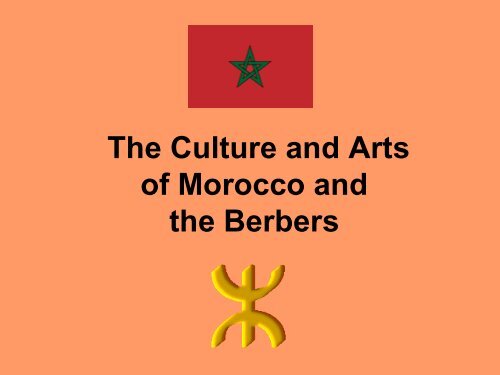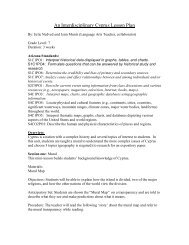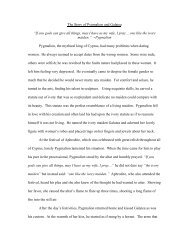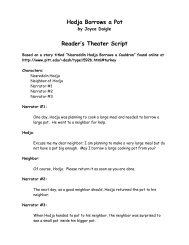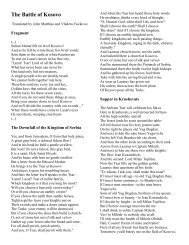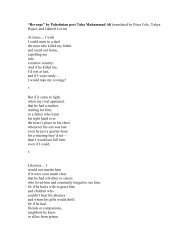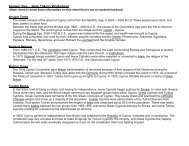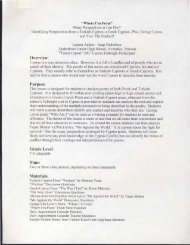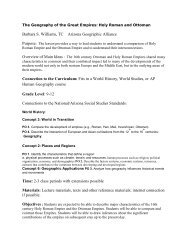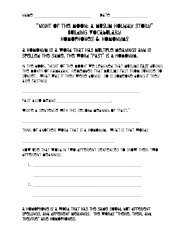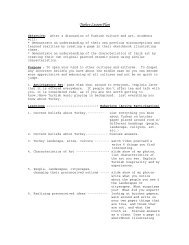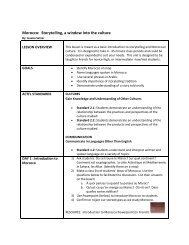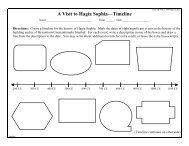The Berbers of Morocco - The Center for Middle Eastern Studies
The Berbers of Morocco - The Center for Middle Eastern Studies
The Berbers of Morocco - The Center for Middle Eastern Studies
Create successful ePaper yourself
Turn your PDF publications into a flip-book with our unique Google optimized e-Paper software.
<strong>The</strong> Culture and Arts<br />
<strong>of</strong> <strong>Morocco</strong> and<br />
the <strong>Berbers</strong>
<strong>Morocco</strong><br />
ocation: Northwest Africa, on Atlantic ocean<br />
Part <strong>of</strong> the Maghreb - the name <strong>for</strong> the alliance <strong>of</strong><br />
North African countries - Algeria,Tunisia, Libya, Mauritania<br />
opulation: 33 million. Area: Slightly larger than Cali<strong>for</strong>nia<br />
Language: Official written language, (not spoken): Classical Arabic<br />
Used <strong>for</strong> <strong>of</strong>ficial government documents & business: French<br />
Common spoken language: Moroccan Arabic (not written)<br />
Common spoken & written: Berber (called Tamazight)<br />
Political System: Constitutional Monarchy with a Legislative & Judicial branch. King<br />
Mohammad VI is the head <strong>of</strong> state and spiritual leader and appoints the prime<br />
minister. <strong>Morocco</strong> gained independence from France in 1956.<br />
Controversy: <strong>The</strong> southern region <strong>of</strong> <strong>Morocco</strong>, aka Western Sahara has been a<br />
disputed territory since 1991. Western Saharan people (Sahrawis) would like to<br />
establish their own country. Currently 200,000 are refugees in Algeria. <strong>The</strong> U.N.<br />
proposed that W.S. be a domestic autonomous region like Tibet. No resolution.<br />
Economics: Newsweek magazine, August 2010, listed <strong>Morocco</strong> 6th in the world amongst<br />
smaller population countries in economic development <strong>for</strong> such sectors as: services<br />
such as tourism, telecom and textiles, mining (world's third-largest producer <strong>of</strong><br />
phosphorus), fishing, salt, construction, manufacturing. Still dependent too much on<br />
agriculture which employs about 45% <strong>of</strong> the population. <strong>The</strong> King has been<br />
instrumental in developing the economy and owns many businesses. When the King<br />
proposed building more dams Moroccans engaged in farming went from 70% to 45%.<br />
Alfalfa, tomatoes, wheat are large crops.
<strong>The</strong> king <strong>of</strong> <strong>Morocco</strong>, Muhammad VI, is unique among all rulers in the Islamic<br />
world as he bears the title ‘Commander <strong>of</strong> the Faithful.’<br />
Below, the King at Throne Day on July 31 st , the anniversary <strong>of</strong> his coronation,<br />
a national holiday.
Religion: 99% Muslim (mostly Sunni moderates, Sufis, and some Shi‘ah). A large Jewish<br />
community lived in <strong>Morocco</strong> be<strong>for</strong>e the creation <strong>of</strong> Israel, numbering approximately<br />
265,000 in 1948. Between 7,000 and live there now.<br />
Ethnic makeup: 99.1% Berber & ethnic Arabs, .7% Other (Christian), .2% Jewish<br />
Climate: Mediterranean which means rain in the winter and dry in the summer. <strong>Morocco</strong> is an<br />
Arid environment on the edge <strong>of</strong> the Sahara desert (which is mostly rock with only some<br />
sand dunes). <strong>The</strong>re are extensive rivers on the Western Plains where they get 15‖-20‖ rain<br />
a year. On the eastern side <strong>of</strong> the country they receive 2‖-3‖ rainfall (a drought and<br />
salt in the water in the south are problems). In the extremely dry areas farming takes place<br />
in the oases areas called Palmeraie‘s (linear oases) <strong>of</strong>ten with ancient systems <strong>of</strong><br />
irrigation (see photo to right).<br />
<strong>The</strong>ir architecture is considered Africanate<br />
because <strong>of</strong> it‘s thick-walled adobe clay buildings<br />
similar to those found in much <strong>of</strong> Africa.<br />
Moroccan women: <strong>The</strong>y have more rights<br />
than many other Arab countries due to<br />
the Kings‘ support – many now are judges,<br />
scholars, and teach/support other<br />
women to grow. Not all women cover up<br />
with the traditional Hijab headscarf –<br />
<strong>Morocco</strong> is considered to be a moderate<br />
Islamic country.
<strong>Morocco</strong>’s Regions<br />
1. Mediterranean Coast &<br />
Rif<br />
2. Fes, Meknes and <strong>Middle</strong><br />
Atlas<br />
3. <strong>Eastern</strong> <strong>Morocco</strong><br />
4. North Atlantic Coast<br />
5. South Atlantic Coast<br />
6. Marrakech and High<br />
Atlas<br />
7. River Valleys and dunes<br />
8. Anti Atlas<br />
9. Southern <strong>Morocco</strong>
Education<br />
• Education is a high priority no in the country. Since 1999 a new program<br />
was instituted by the government called ―Decade <strong>of</strong> Excellence‖ – to teach the<br />
importance <strong>of</strong> changing <strong>Morocco</strong> through education and to re<strong>for</strong>m the education<br />
system to include preschool education. <strong>The</strong> government is also trying to<br />
introduce the American system <strong>of</strong> education.<br />
• Preschool - children go to koranic schools where they learn Arabic.<br />
• Primary school – 6 – 12 years (Muslim children read Koran, Jewish read the<br />
Torah). Many children leave school at 12 years old to help their parents farm.<br />
• Secondary school – 13 – 15 years – called ―Idadiya‖<br />
• High school (16-18) called ―Taniwiya‖<br />
History & Geography taught in Arabic<br />
Math & Social Sciences taught in French<br />
• University – taught only in French (so you must read, write and speak French!)
<strong>The</strong> <strong>Berbers</strong><br />
• <strong>The</strong> name Berber is a variation <strong>of</strong> the Latin original word ―Barbarian‖, earlier in history<br />
applied by the Romans specifically to their northern hostile neighbors from Germania. <strong>The</strong><br />
Barbary coast, on the coast <strong>of</strong> northwest Africa was named after the <strong>Berbers</strong> because they<br />
and Arabs pirated ships going to the Mediterranean Sea. <strong>The</strong> <strong>Berbers</strong> call themselves<br />
"Imazighen", meaning the free. <strong>Berbers</strong> are non-Arabic tribes that are <strong>of</strong>ten referred to as<br />
Arab-Islamic. Over the last several hundred years many Berber peoples have converted to<br />
Islam.<br />
• History: <strong>The</strong> <strong>Berbers</strong> are known to have been in North Africa at least in 3000 B.C. <strong>The</strong>y are<br />
thought to have come across northern Africa. Many early Roman, Greek, and Phoenician<br />
colonial accounts mention a group <strong>of</strong> people collectively known as <strong>Berbers</strong> living in northern<br />
Africa. Other waves <strong>of</strong> Berber immigration came in the 3 rd and 11 th centuries. Some <strong>Berbers</strong><br />
trace their lineage to Yemen.<br />
• Population: <strong>Morocco</strong> has the majority <strong>of</strong> <strong>Berbers</strong>, 10.4 million (40% <strong>of</strong> the population).<br />
<strong>The</strong>se can be divided into three main groups with different dialects: the Riffians, the Chleuh<br />
and the Central Moroccan Amazigh. <strong>The</strong>y are also in neighboring Saharan countries: Algeria,<br />
Tunisia, Libya, and Egypt, with mainly Tuareg <strong>Berbers</strong> living in Mauretania, Niger, Mali, and<br />
Burkina-Fasso. Two-thirds <strong>of</strong> <strong>Berbers</strong> live in rural and mountainous areas, most being<br />
farmers. Prior to independence in 1956, half <strong>of</strong> <strong>Morocco</strong> were <strong>Berbers</strong>. After this Arabic<br />
became the main language and an Arabization period began (government-initiated agenda to<br />
counter French colonial values).<br />
• Housing is clay, adobe, stone and/or brick, and <strong>for</strong> nomadic <strong>Berbers</strong>, tents made out <strong>of</strong> wool<br />
and goat hair. Often the extended family will have a few dwellings on a property with a wall<br />
around them (also called a compound) so that they have an area to garden, keep goats, etc.<br />
But more families live in separate housing more than ever be<strong>for</strong>e.
Many people dress in<br />
Berber style blue<br />
robes. <strong>The</strong>se are<br />
carpet sellers in<br />
Ourzazate, in the<br />
heart <strong>of</strong> <strong>Morocco</strong> &<br />
Berber territory.<br />
<strong>Morocco</strong>‘s mixture <strong>of</strong><br />
races and culture<br />
includes <strong>Berbers</strong><br />
intermarrying with<br />
Arabs and other<br />
Africa tribal people.
An artist who also runs a Jewish artifact ―museum‖ in Ourzazate.
A Berber encampment from high on a sand dune.
A Berber Toy Tent
Economy<br />
<strong>Berbers</strong> are <strong>of</strong>ten portrayed as nomadic people crossing the desert<br />
on camels, but most are farmers in the mountains and valleys<br />
throughout northern Africa. Some do trade throughout the region.<br />
Historically Berber merchants were responsible <strong>for</strong> transporting goods<br />
by camel caravans. <strong>The</strong>re were basically five Trans-Saharan trade<br />
routes which extended across the Sahara from the northern<br />
Mediterranean coast <strong>of</strong> Africa to the great cities, which are situated on<br />
the southern edge <strong>of</strong> the Sahara, such as Timbouctou in Mali. From<br />
there the goods were distributed throughout the world.<br />
Traditionally, <strong>Berbers</strong> raise sheep, cattle and goats. Some <strong>Berbers</strong><br />
work in flourmills, do woodcarving, quarry millstones, and make<br />
pottery or jewelry. Women generally do the cooking and caring <strong>for</strong> the<br />
home and children, weaving, and pottery. Today, many <strong>Berbers</strong> work<br />
in Spain or France as migrant workers and send money home to their<br />
family.
Most <strong>Berbers</strong> were originally Nomadic (moving their home and not<br />
staying in one place to graze their sheep and goats and take advantage<br />
<strong>of</strong> better weather, living in tents as here).
<strong>The</strong>se Berber families move to summer and winter<br />
climates that benefit their families and goats & sheep.
A Berber woman on a windy day in her summer home. We<br />
snapped this from the road with a long lens.
Political Systems<br />
Berber society is made up <strong>of</strong> families who are members <strong>of</strong> a tribe which is a member <strong>of</strong> a<br />
clan <strong>of</strong> tribes. Each tribe has a chieftain. <strong>The</strong> French had the tribes organized into<br />
confederations to control them. After independence the King created 16 regions <strong>of</strong> <strong>Morocco</strong><br />
based around geographic areas.<br />
Most <strong>Berbers</strong> were farmers. At one time, tilling the land was considered the work <strong>of</strong> the lower<br />
classes, while the upper classes were merchants. Usually, groups <strong>of</strong> sedentary <strong>Berbers</strong> paid<br />
allegiance to a locally appointed headman, who in turn reported to the noble who considered<br />
the village his domain. As time has passed, however, these sedentary farmers have been<br />
able to accumulate wealth while the trans-Saharan trade routes diminished in importance.<br />
<strong>The</strong>y were also given political status by colonial and postcolonial administrations.<br />
<strong>The</strong> Zawiya & the Saints<br />
Berber communities have<br />
clans/families claiming<br />
descent from the Prophet<br />
(Sharifs), who are regarded<br />
as holy men having<br />
supernatural powers. <strong>The</strong>y<br />
act as mediators <strong>for</strong> the<br />
village and people can<br />
come to stay in the Zawiya<br />
if they have problems and<br />
be protected.
Religion<br />
• Most <strong>Berbers</strong> are at least nominal<br />
followers <strong>of</strong> Islam, and many strictly<br />
observe Islamic traditions. Most <strong>of</strong> the<br />
feasts are observed and celebrated, but<br />
the fasting that is required during<br />
Ramadan is <strong>of</strong>ten excused <strong>for</strong> those<br />
who travel. Most <strong>Berbers</strong> are Sunni*<br />
Muslims <strong>of</strong> the Maliki school.<br />
• Like most followers <strong>of</strong> Islam in northern<br />
Africa, many <strong>Berbers</strong> believe in the<br />
continuous presence <strong>of</strong> various spirits<br />
(djinns).<br />
Shia:<br />
Sunni:<br />
Sufis:
Social Organization / Customs & Traditions<br />
:<br />
Tribal Life: It‘s all about the tribe. Fard is a word which means that “the individual is nothing<br />
without the tribe”. <strong>The</strong> nuclear and extended family comes first and is most important. Family<br />
members can live together, or at least most members stay close, and the women and children <strong>of</strong><br />
an extended family work together in the home. To be alone is thought to be a sad condition.<br />
Children are cared <strong>for</strong> by older children in the extended family. Patriarchy is strong. Men work<br />
outside the home as farmers, merchants in their shops, educators etc. Women and children also<br />
work in the fields, carrying crops home etc. <strong>The</strong>y also make artisanal crafts with palms and reeds<br />
and other natural materials. Children have to help their families by doing chores. Some family<br />
members move away to cities in<br />
<strong>Morocco</strong> and to Europe (to be migrant<br />
workers) and America and send money<br />
back to the extended family. <strong>The</strong>ir value<br />
system is ―I‘m going to work <strong>for</strong> my family<br />
and make it possible <strong>for</strong> everyone to live<br />
better‖.<br />
(Right) Guests are held in high esteem<br />
and treated very well. Hospitality is taken<br />
very seriously.
<strong>The</strong> Spiritual Dimension in Berber Design<br />
• James Jereb, in his book <strong>The</strong> Arts and Crafts <strong>of</strong> <strong>Morocco</strong>, describes Berber<br />
designs as "a testimony not only to the meditative and aesthetic power that<br />
decoration holds <strong>for</strong> them, but a faith in supernatural power. Many pieces are valued<br />
not because <strong>of</strong> appearance alone--perhaps because <strong>of</strong> their <strong>for</strong>m or the way in which<br />
they are decorated--but because they may contain a power known as baraka, a<br />
concept deeply embedded in Moroccan religious beliefs and crucial to the<br />
understanding <strong>of</strong> all artistic traditions in <strong>Morocco</strong>.<br />
• Baraka has many meanings in <strong>Morocco</strong>, but it is principally the positive<br />
power <strong>of</strong> the saints. It is a source <strong>of</strong> inspiration among most Moroccan<br />
artisans...Baraka permeates all things to varying degrees; not only can it exist in<br />
jewelry, talismans and other manufactured objects, such as ceramics and textiles, it<br />
is also thought to suffuse plants, such as henna and oleander, and incenses, such as<br />
sandalwood and myrrh. This power is transferred to objects and textiles by the use <strong>of</strong><br />
a particular artistic vocabulary <strong>of</strong> symbols, designs, motifs, colors and techniques that<br />
protect the object, creator and consumer." (<strong>The</strong> Arts and Crafts <strong>of</strong> <strong>Morocco</strong> p. 13)<br />
• Baraka is sought and used to deal with the darker <strong>for</strong>ces <strong>of</strong> life, curing<br />
illnesses and protecting oneself against the evil jnoun (spirits--the source <strong>of</strong> the<br />
English word "genie") and the evil eye.<br />
• Berber symbols are included in the design <strong>of</strong> everyday objects to protect the<br />
object as well as the person who uses or wears it. <strong>The</strong>se motifs appear in all aspects<br />
<strong>of</strong> the Berber artisanal tradition, including pottery, leatherwork and textiles, not to<br />
mention all types <strong>of</strong> personal adornment. <strong>Berbers</strong> found many ways to adorn<br />
themselves with jewelry, tattoos and henna. It is mostly Berber women who are<br />
tattooed. Because tattoos are <strong>for</strong>bidden by Islam, many women have found other<br />
outlets <strong>for</strong> placing their protective motifs by including them in textiles they weave and<br />
in jewelry and henna. Thus, the designs that are drawn in henna on the hands and<br />
feet <strong>of</strong> a bride on the eve <strong>of</strong> her marriage are these same protective and nurturing<br />
symbols that have evolved throughout centuries <strong>of</strong> use.
<strong>The</strong> Arts: God loves beauty, God is beauty. – Islamic ideal<br />
Women are the carriers <strong>of</strong> the cultural & ethnic identity<br />
through their art <strong>for</strong>ms – jewelry, carpet & fabric<br />
weaving, fashion, and embroidery.
<strong>The</strong> Marriage Ritual<br />
Necklaces,<br />
headdresses and<br />
bracelets using silver,<br />
coral, amber, beads<br />
Colors & Designs<br />
have meaning
Makeup <strong>for</strong> a<br />
wedding or special<br />
ritual is very<br />
distinctive. Black<br />
charcoal is put on the<br />
eyebrows and as<br />
eyeliner, with rouge<br />
on the cheeks. Notice<br />
the tattoo on her chin<br />
and nose.
Vintage photos from southern <strong>Morocco</strong>.<br />
Notice the woman’s tattoo on <strong>for</strong>ehead and<br />
chin.<br />
Although tattooing is no longer<br />
practiced by most Amazigh women, in<br />
the recent past, when a girl reached<br />
puberty, sometime between the ages <strong>of</strong><br />
eleven and fourteen (a time that<br />
generally coincided with her first<br />
menstrual cycle), her mother, aunts, or<br />
family friends would tattoo her face and<br />
wrists. Tattooing was a rite <strong>of</strong> passage,<br />
marking a girl‘s transition into<br />
womanhood. Usually small groups <strong>of</strong><br />
girls were tattooed at the same time,<br />
making it a very social activity, shared<br />
and passed on among women.<br />
* Today tattooing is a violation <strong>of</strong><br />
Islamic law so no one under 30 has<br />
tattoos.
Bert Flint who started the<br />
Tiskiwin Museum in Marrakech<br />
to preserve the arts <strong>of</strong> Saharan people.
Necklace pouches <strong>for</strong> carrying things.
Jewelry<br />
• Silver – earrings,<br />
pendants,<br />
necklaces, beads<br />
• Amber, coral<br />
• Cabachon-cut<br />
gems (convex,<br />
unfaceted)<br />
• Enameling with<br />
color (not shown<br />
here)<br />
• Leather work
Distinctive Berber symbols on silver necklace.
Silversmith demonstration <strong>of</strong> making a<br />
southern Moroccan cross in Amezrou, Zagora.<br />
<strong>The</strong> silversmiths and the blacksmiths, trained<br />
by the old Jewish population, are still using<br />
the models left by them to make fibula (pins<br />
to hold garments together) and medallions.
Amulets or Talisman<br />
An Amulet is a piece <strong>of</strong> jewelry usually hung<br />
about the nect and thought to be a magical<br />
protection against evil or disease.<br />
A Talisman is similar but the definition says<br />
it‘s marked with magic signs or believed to<br />
give its‘ bearer supernatural powers or<br />
protection.<br />
<strong>The</strong> Hamsa (Khamsa)<br />
• One <strong>of</strong> the most popular amulets used<br />
throughout the <strong>Middle</strong> East & North Africa is<br />
the open hand which is used as a defense<br />
against the ‗evil eye‘. It is a protective amulet<br />
that represents blessings, power, and<br />
strength. <strong>The</strong> symbolism <strong>of</strong> the hand raised,<br />
palm outwards is to repel some threatened<br />
evil.<br />
• <strong>The</strong> 5 fingers represent the five pillars <strong>of</strong><br />
Islam and are said by some to represent the<br />
most sacred people in Islam – Muhammad,<br />
Ali, Fatima, Hassan and Husain.<br />
• It is believed to have originated with the<br />
ancient practices <strong>of</strong> the Phoenicians.<br />
• An eye is <strong>of</strong>ten designed into the center <strong>of</strong><br />
the hand.<br />
• <strong>The</strong> renewed interest in Kabbalah and<br />
mystical Judaism is a factoring in bringing the<br />
hamsa pendant back into vogue.
<strong>The</strong> Mulhafa: A new elegant<br />
style <strong>for</strong> women, originated by<br />
Sahrawi women (people <strong>of</strong> the<br />
Sahara) <strong>of</strong> southern <strong>Morocco</strong>. Tiedyeing<br />
is common as well as bright<br />
colors.
Embroidered veils & head coverings called Tahruyt<br />
• With the decline <strong>of</strong> tattooing as a means <strong>of</strong> conveying expressive and social functions, its artistic<br />
<strong>for</strong>ms and symbolism have been transferred to the embroidered "veils" (13) or head coverings,<br />
called tahruyt, worn by Amazigh women in some areas <strong>of</strong> southern <strong>Morocco</strong>. In the early and middle<br />
twentieth century, these long, sparsely decorated, indigo-dyed cotton cloth head coverings were<br />
worn simply as modesty garments. Indigo is today primarily imported into the region, but it was<br />
cultivated in southern <strong>Morocco</strong> from as early as the sixteen century until as late as the 1960s<br />
(Balfour-Paul 1997:205). <strong>The</strong> use <strong>of</strong> indigo head coverings distinguishes Amazigh women in<br />
southern <strong>Morocco</strong> from many other Amazigh groups in the <strong>Middle</strong> Atlas and High Atlas Mountains <strong>of</strong><br />
<strong>Morocco</strong>, who once commonly wore wool shawls rather than any type <strong>of</strong> "veil" or head covering<br />
(Fig. 13). South <strong>of</strong> the Atlas Mountains the climate becomes drastically hotter and drier, making it<br />
practical <strong>for</strong> women to wear some type <strong>of</strong> covering to protect them against harsh sun and sandstorms.<br />
Indigo-dyed cotton coverings are ubiquitous throughout the Saharan regions <strong>of</strong> Africa, as<br />
the use <strong>of</strong> indigo was thought to have cosmetic and medicinal benefits, conditioning women‘s skin<br />
and improving their complexions. <strong>The</strong> Kel Tamacheq women, popularly referred to as Tuareg, an<br />
Amazigh group living in the desert regions <strong>of</strong> Niger, Algeria, Burkina Faso, and Mali, commonly<br />
wear indigo-dyed head coverings and clothing (Fig. 14). Hassaniya Arab women living throughout<br />
Mauritania and northern Senegal also cover themselves with indigo head coverings (Du Puigaudeau<br />
1970:13).<br />
• In the 1970s, coinciding with the disappearance <strong>of</strong> tattoos, Amazigh women began to embroider<br />
elaborate vegetal motifs on their tahruyt, demonstrating the living and dynamic nature <strong>of</strong> their arts<br />
(Fig. 15). Women begin by embroidering a central band, called a tanammast, which <strong>for</strong>ms a ground<br />
line <strong>for</strong> the other embroidered motifs that appear to rise up or grow out <strong>of</strong> it. <strong>The</strong> tanammast divides<br />
the cloth <strong>of</strong> the tahruyt into two equal halves and women align their patterns symmetrically so that<br />
the motifs are always balanced bilaterally, the designs on both the top and bottom <strong>of</strong> the tanammast<br />
serving as mirror images <strong>of</strong> each other (Cover).<br />
• As with those used in weaving, these embroidered motifs associate women with the natural world.<br />
<strong>The</strong> women I spoke with consistently described the motifs adorning their head coverings as<br />
"flowers," "bird tracks," "shafts <strong>of</strong> wheat," "trees," or other natural objects associated with fertility,<br />
plenty, and prosperity. For instance, the neon green zig-zag designs embroidered on the border<br />
hanging over the woman‘s left shoulder in the Cover picture was said to resemble pigeon prints. In<br />
southern <strong>Morocco</strong>, oral poetry and songs <strong>of</strong>ten compare women to pigeons. (14)<br />
• From Amazigh textiles and dress in <strong>Morocco</strong>: metaphors <strong>of</strong> motherhood article by Cynthia Becker, Phd.
Design Symbols & <strong>The</strong>ir Meaning:<br />
<strong>The</strong> head covering on the cover on this book, from<br />
which most <strong>of</strong> the research on women shaping Berber<br />
identity shows the most common motif found on<br />
embroidered head coverings, a small triangle that is called<br />
takhbasht, which means "claws" and which women told me<br />
looks like the marks animal claws make on the ground—<br />
another example <strong>of</strong> a tikselt or "metaphor." <strong>The</strong> triangle<br />
motif is also omnipresent, as in other Amazigh textiles,<br />
jewelry, and tattoo designs. Flower motifs, clear references<br />
to fertility, are also embroidered with curvilinear stitches<br />
(Fig. 15). In sum, the embroidered motifs on the tahruyt<br />
<strong>of</strong>ten appear to create a large, fertile landscape covered<br />
with vegetation.<br />
Colors used in the decoration <strong>of</strong> the tahruyt also<br />
suggest a connection between the fertility <strong>of</strong> the land<br />
and the fertility <strong>of</strong> women. Women purchase previously<br />
dyed wool yarn in the market <strong>for</strong> use in their embroidery<br />
and colors are categorized into light and dark hues.<br />
Although purple, bright blue, pink, neon green, and<br />
other colors are embroidered on the dark cloth, these<br />
colors fall within the basic color palette <strong>of</strong> red, green,<br />
yellow, and black. In the Cover picture, circular motifs in<br />
pink and red, colors categorized as light, resembling the<br />
sunlight, are embroidered above the other motifs. <strong>The</strong>y<br />
hover like the sun above the other designs, creating a<br />
composition that resembles the natural world and its<br />
plentifulness, connecting women to fertility.<br />
- Cynthia Becker, Phd.
<strong>The</strong> Art <strong>of</strong> Body Adornment with Henna<br />
(also a cash crop <strong>for</strong> southern <strong>Morocco</strong>)
Some reasons <strong>for</strong> Women Using Henna & tattooing<br />
Throughout <strong>Morocco</strong>, substances containing baraka, such as saffron or henna, are<br />
believed to infuse the body with positive healing energy and are applied during rite<strong>of</strong>-passage<br />
ceremonies that typically include blood flow, such as male circumcision<br />
or the loss <strong>of</strong> female virginity during a wedding ceremony, as on the saffron-painted<br />
bride. Pollution categories in Islam are based on the idea that the inner and outer<br />
bodies are separated into discrete, mutually exclusive elements that must be kept<br />
apart. However, certain substances can cross from the outer physical body to the<br />
inner spiritual body and purify the inner body, especially those substances containing<br />
I baraka believe (Marcus it is not 1992:74). coincidental that Moroccan women chose to tattoo their bodies with<br />
substances containing baraka to symbolically enhance their bodies after first<br />
menstruation, a crucial moment in the life cycle. Tattoos can be seen as a means <strong>of</strong><br />
both augmenting women‘s bodies and <strong>of</strong> publicly marking their transition from childhood<br />
to womanhood, as a physical and ever-present symbol <strong>of</strong> their prestige as useful<br />
members <strong>of</strong> the society, who ensure the survival <strong>of</strong> the group through their ability to<br />
give birth.<br />
Particular tattoo motifs, including a variety <strong>of</strong> geometric designs, generally varied from<br />
group to group in <strong>Morocco</strong>; however, tattoo designs also reflected personal style<br />
preferences.
Tattoos <strong>for</strong> women in the <strong>Middle</strong> East<br />
• In Iran, it was common <strong>for</strong> upper class women to have patterns tattooed on their chins. <strong>The</strong> designs<br />
were sometimes very elaborate, and resembled that <strong>of</strong> a beared. Along side the chin tattoos, it was<br />
common <strong>for</strong> women to tattoo their lips blue, as it was considered to embody beauty. Beliefs attached to<br />
tattoos in the middle east <strong>of</strong>ten corresponded with thinking the wearer was imbued with magical power,<br />
these tattoos <strong>of</strong>ten times were dots or small crosses. <strong>The</strong>y usually adorned the hands, and feet, they<br />
believed that they either provided strength or protection.<br />
• Tattooing is nevertheless common among the <strong>Berbers</strong> <strong>of</strong> North Africa, where small designs with<br />
symbolic meaning are used (mainly by women). Egyptian Christians <strong>of</strong>ten have a cross tattooed on<br />
their hand or wrist. <strong>The</strong>se designs are very simple – <strong>of</strong>ten crudely done – and we are not aware <strong>of</strong> any<br />
Arab equivalent tot he elaborate tattoos used, <strong>for</strong> example by the Maoris and Pacific islanders.<br />
• However, in this day and age, the demand <strong>for</strong> tattoos among Iranian, and other middle eastern women<br />
has exploded Iranian who are tattooed, however must keep them under wraps due to the authorities.<br />
• <strong>The</strong> art <strong>of</strong> tattoo in the middle east is <strong>for</strong>bidden by religious scriptures. In despite <strong>of</strong> this restriction there<br />
are those who have a need or desire to get tattooed. Some see it as a way to allow themselves to get<br />
closer to God while others use it as a way to remember some great event in their life. Tattooing was<br />
also used as a rite <strong>of</strong> passage.<br />
• For a non-permanent skin decoration in the Arab world is practiced mostly by women and takes the<br />
<strong>for</strong>m <strong>of</strong> designs on hands and feet using henna, which fades away after a few weeks. <strong>The</strong> complex<br />
patterns seen throughout the <strong>Middle</strong> East are normally achieved using stencils which can be bought<br />
cheaply in the souks (markets).
Rug Styles and Symbols<br />
• Traditional Berber carpets contain distinctive patterns<br />
and colors and are woven from sheep wool or camel hair<br />
(you can also find them made from nylon and olefin<br />
material). <strong>The</strong> materials are hand-washed and naturally<br />
dyed from saffron yellow, to wild mint green, and<br />
from pomegranate and henna. <strong>The</strong>se carpets are known<br />
<strong>for</strong> their strong geometric designs, and have been dated<br />
them as far back as the Marinid era (Berber dynasty).<br />
Carpets in the <strong>Middle</strong> Atlas generally have a traditional<br />
diamond grid.<br />
• Amazigh textiles, because <strong>of</strong> the tribes' relative isolation<br />
in rural areas, have preserved ancient weaving techniques<br />
and mystic symbolism. In this society even the wool itself<br />
has special protective powers.<br />
• <strong>The</strong> Berber tribes developed a variety <strong>of</strong> weaves to be<br />
adaptable to different climates. <strong>The</strong> rugs in the mountains<br />
have larger loops, are more loosely knotted to provide<br />
protection against the cold. In warmer climates the rugs<br />
are made with a finer weave.<br />
• Berber weaving is highly dependent on the female<br />
culture, and is passed down traditionally within the home.<br />
<strong>The</strong> young apprentice is expected to learn the different<br />
looping techniques, patterns, color ranges and motifs.<br />
Historically women wove carpets <strong>for</strong> their families, and<br />
men traditionally produced carpets that were more<br />
specialized as pr<strong>of</strong>essional masterweavers.
<strong>The</strong> bold colors, in depth patterns and weaving techniques <strong>of</strong> different regions<br />
have their own distinct style. Each tribe has a signature pattern and commonly<br />
unfold a story, revealing acts <strong>of</strong> ceremony, or designs that <strong>of</strong>ten relate to fertility<br />
and protection. Like any other type <strong>of</strong> abstract art, interpretations can be better<br />
understood with additional knowledge <strong>of</strong> the culture, songs and legends.<br />
Women Artisans<br />
Associations all<br />
over <strong>Morocco</strong> are<br />
empowering<br />
women by<br />
allowing them to<br />
make extra<br />
money. A Berber<br />
rug with the<br />
diamond pattern<br />
and symbols<br />
below, made by<br />
women in a small<br />
village and sold<br />
at the<br />
association.
Berber Women’s Textile & Carpet Designs<br />
(from Lucien Viola’s Vintage collection and book)
Regions & Confederations <strong>of</strong> Berber Tribes <strong>of</strong> <strong>Morocco</strong><br />
live in the High Atlas Mountains Region in the north, Mid-Atlas Mountains<br />
Region in the middle, and Anti-Atlas Mountains Region in the south
Ceramic Art <strong>of</strong> Berber women<br />
<strong>The</strong> domain <strong>of</strong> Berber pottery extends<br />
west to east from <strong>Morocco</strong> (<strong>Middle</strong> Atlas and<br />
Rif) to Tunisia and covers northern Algeria,<br />
from the Oran region to the Aurès Mountains<br />
and Small Kabylia. <strong>The</strong> cradle <strong>of</strong> the most<br />
refined Berber production is Kabylia in<br />
Northern Algeria.<br />
<strong>The</strong> Berber women use neither wheel nor kiln to make their pottery.<br />
<strong>The</strong> pieces are shaped by hand and cooked in the open air. In this<br />
way, they more closely resemble objects discovered in archaeological<br />
digs at megalithic burial sites in Northern Africa than they do ancient<br />
Mediterranean pottery shaped on a wheel and cooked in a kiln. <strong>The</strong><br />
fragility and daily use <strong>of</strong> these objects explains why there are no<br />
examples pre-dating the 19th century. It is the archaic style used to<br />
create the pottery that gives it its antiquity. <strong>The</strong> geometric patterns<br />
decorating the pieces – which are also found on the women‘s textiles<br />
and tattoos – carry symbolic meaning, whose origin traces back to the<br />
Neolithic era and was present on all continents.
Tuareg <strong>Berbers</strong><br />
Tuaregs are known <strong>for</strong><br />
wearing indigo blue<br />
colored robes and<br />
turbans and leading<br />
caravans across the<br />
Trans-Saharan trade<br />
routes as well as their<br />
music now.
<strong>The</strong> Tuaregs<br />
• Who are they: Tuareg prefer to call themselves Imouhar(en), Imashagen or Kel tamasheq. Tuaregs are<br />
a mixture <strong>of</strong> Whites (<strong>Berbers</strong>) and Blacks (sub-saharan people). <strong>The</strong>y speak Tamarshak, a dialect <strong>of</strong> the<br />
old Berber language, and have preserved an ancient script (Tifinagh) similar to that used by the ancient<br />
Libyans.<br />
• Where do they live: <strong>The</strong>y are a nomadic Berber people numbering some 1.5 million people and living<br />
mainly in the Sahel states <strong>of</strong> Niger, Mali, Côte d Ivoire and Burkina-Faso, and in the Saharan districts <strong>of</strong><br />
the Maghreb – Algeria, Tunisia, Libya, Mauritania and Egypt. <strong>The</strong>re are even some tribes in Sudan, and<br />
Bénin. <strong>The</strong>y migrate over a huge area <strong>of</strong> the Sahara and the Sahel crisscrossing existing national<br />
borders. <strong>The</strong>ir territory is essentially the Sahara desert, but the aridity <strong>of</strong> this part <strong>of</strong> the world <strong>for</strong>ces<br />
them to camp in the various mountains emerging from the desert, <strong>of</strong> Mali Niger, and southern<br />
• Political Life: <strong>The</strong>ir political organizations extend across national boundaries and as a result they live in<br />
constant strife with the central authorities. <strong>The</strong>y live in tribal confederations that include the tribes <strong>of</strong> the<br />
Ahaggar and Ajjer mountains in the north, and the Asben, I<strong>for</strong>a, Itesen, Aulliminden and Kel-Tademaket<br />
in the south. <strong>The</strong>ir virtual country has its spiritual and historic capital in Taddamakat in Mali. Another<br />
important city is Tagedda in Niger.<br />
• Economy: In the past they were great raiders <strong>of</strong> caravans and <strong>of</strong> other tribes, provided guides <strong>for</strong> trans-<br />
Saharan caravans, exacted tribute from them and engaged in the salt trade. When there was no more<br />
trade and desertification took over many moved to the <strong>Middle</strong> Atlas to settle. <strong>The</strong> terrible droughts <strong>of</strong> the<br />
70‘s and 80‘s hit them hard, killing most <strong>of</strong> their livestock and <strong>for</strong>cing many <strong>of</strong> them to look <strong>for</strong> jobs in<br />
farming, trade and industry. Southe6rners breed cattle and camels, and northerners mainly goats.<br />
• Social organization & customs: <strong>The</strong>ir society was feudal and hierarchical, and included noble,<br />
religious, vassal, craftsmen and slave classes which are now being gradually eroded. When on the move<br />
they live in tents <strong>of</strong> red dyed skin. Adult males wear a distinctive blue veil over the lower part <strong>of</strong> the face<br />
which it is a shame <strong>for</strong> them to remove.<br />
• Religion: <strong>The</strong>y share with Arabs their culture and their Islamic religion. Maybe Christianity had a certain<br />
influence on them - Tuareg blacksmiths sculpt beautiful crosses. Even if religion plays an important role<br />
in their life, they are not considered very devout. <strong>The</strong> main points <strong>of</strong> the religion are respected - prayer,<br />
abstinence from pork, observance <strong>of</strong> holidays. From: www.tuaregs.free.fr www.saharafragile.org
Tuaregs are known <strong>for</strong> their music (like world/trance<br />
music) and now play with electric guitars. <strong>The</strong> Tuareg<br />
Festival is held each year in Nigeria.<br />
Moussa Ag Keyna <strong>of</strong> Toumast,Tuareg ―nomad rocker‖
Etran Finatawa,<br />
a music group<br />
combining<br />
Niger and<br />
Tuareg<br />
musicians
Tuareg Silver jewelry<br />
All Tuareg photos from TUAREG JEWELRY by Helene Hagan
Leather design, <strong>of</strong>ten used as saddles on camels.
Leather designs on camel saddle bags.
You can see the camel saddle bags below. Petroglyphs and<br />
paintings such as the example on the right have been found in<br />
southern <strong>Morocco</strong> and dated to be 6000 years old.
Berber Symbols can be found in weaving, tattoos, jewelry & henna designs<br />
1.OLIVE TREE: Strength because <strong>of</strong> its Berber name azemmur, diverted from the term tazmat (strength).<br />
2.WHEAT: is associated with Life (because <strong>of</strong> it sheath) and Death (because <strong>of</strong> the seeds being in the ground).<br />
3. TREE: is related to an easy life, happinness and fertility.It symbolises the centre <strong>of</strong> the world surrounded by<br />
Beings,objects and spirits. It also means Life (because <strong>of</strong> the roots) and knowledge (because <strong>of</strong> the<br />
leaves).<br />
4. SEEDS: Male seeds and it is a symbol <strong>for</strong> Life and Fertility.<br />
5. HAMMER: Power, natural <strong>for</strong>ces and creative power. It is a very important instrument <strong>for</strong> the blacksmith<br />
because it enables him to change the iron into various shapes.<br />
6. ANCHOR: Solidity, continuity, faithfulness, balance and lucidity.<br />
7. AXE: A sharp instrument which represents anger and destruction, but as it does attack evil <strong>for</strong>ces, it is a<br />
positive symbol. It is also associated with the lightning and rain there<strong>for</strong>e fertility.<br />
8. ARROW: Cosmic projection. Associated with lightning and represents male energy and fertility.<br />
9. SUN: Life, power. It is a source <strong>of</strong> Life, heat and light but could also be an evil <strong>for</strong>ce because it does drain the<br />
waters and can destroy the crops.
10. MOON: Associated with feminity and represents change, fertility and the perpetual cycle.<br />
11. WEAVING COMB: It represents the movement <strong>of</strong> the world, balance, cohesion and tidiness.<br />
12. SHIP:< Associated with water and means strength, blessing, wisdom.<br />
13. CRESCENT: Change, revival, Openness, birth,death and resurrection <strong>of</strong> the full moon.<br />
14. CROSS: movement, space with different directions: up/down - North and South, left/right -East/West.<br />
15. SWASTIKA: Symbol <strong>for</strong> a bird there<strong>for</strong>e the creative taking <strong>of</strong>f <strong>of</strong> Life.<br />
16.CROSS WITH SIX BRANCHES: Movement and space but also solidity, anchoring and grounding.<br />
17. DIAMOND: Feminity womanhood and fertility. It is associated with the snake and represents the union <strong>of</strong><br />
opposites.<br />
AMEL TAFSOUT (01.10.2003) from website: www.ameltafsout.com
<strong>The</strong> Berber language has not been written - until fairly recently - except as short inscriptions<br />
on monuments. <strong>The</strong> Berber alphabet that was used <strong>for</strong> this task in antiquity is called<br />
Tifinagh which means ―our finding”. and consists <strong>of</strong> a number <strong>of</strong> geometric-looking phonetic<br />
symbols. It is probably derived from the Phoenician alphabet and has only symbols <strong>for</strong><br />
consonants. Some Berber activists have tried to augment the consonant symbols with vowel<br />
symbols. This modern <strong>for</strong>m <strong>of</strong> Tifinagh is sometimes heroically used to write Berber, most<br />
<strong>of</strong>ten only by the Berber activists. Most people who are literate in Berber use the Latin letter<br />
system <strong>for</strong> writing Tamazight.
Vocabulary & Definitions<br />
Maghreb:<br />
Monarchy:<br />
Arabization:<br />
Berber:<br />
Imazighen:<br />
Tribe:<br />
Clan:<br />
Fard:<br />
Zawiya:<br />
Sahrawis:<br />
Tuaregs:<br />
Nomadic people:<br />
Sedentary people:<br />
Islam:<br />
Muslim:<br />
Qur‘an: Islamic holy book believed to have been dictated by God to the prophets including Muhammad. It means ―recitation‖. Refers to the scripture as<br />
recited in Arabic.<br />
Shia:<br />
Sunni:<br />
Sufi:<br />
Baraka:<br />
Tahruyt<br />
Hijab:<br />
Chador:<br />
Niqab:<br />
Jellaba:<br />
Melhafa:<br />
Africanate:<br />
Medina:<br />
Souk:<br />
Desertification:<br />
Oasis:<br />
Palmeriae:<br />
Trans Saharan trade routes:<br />
Timbouctou:<br />
Zed symbol:<br />
Motif:


